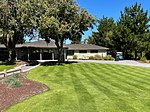17-Mile Drive

17-Mile Drive is a scenic road through Pebble Beach and Pacific Grove on the Monterey Peninsula in California, much of which hugs the Pacific coastline and passes famous golf courses, mansions and scenic attractions, including the Lone Cypress, Bird Rock and the 5,300-acre Del Monte Forest of Monterey Cypress trees.The drive serves as the main road through the gated community of Pebble Beach. Inside this community, nonresidents have to pay a toll to use the road. Like the community, the majority of 17-Mile Drive is owned and operated by the Pebble Beach Corporation. The 17-Mile Drive is a 17-mile (27 km)-long scenic loop having five primary entrances - the main highway entrance at California State Route 1, and entrances in Carmel and Pacific Grove.
Excerpt from the Wikipedia article 17-Mile Drive (License: CC BY-SA 3.0, Authors, Images).17-Mile Drive
17 Mile Drive,
Geographical coordinates (GPS) Address Nearby Places Show on map
Geographical coordinates (GPS)
| Latitude | Longitude |
|---|---|
| N 36.584839 ° | E -121.9651 ° |
Address
17 Mile Drive 3127
93953
California, United States
Open on Google Maps






